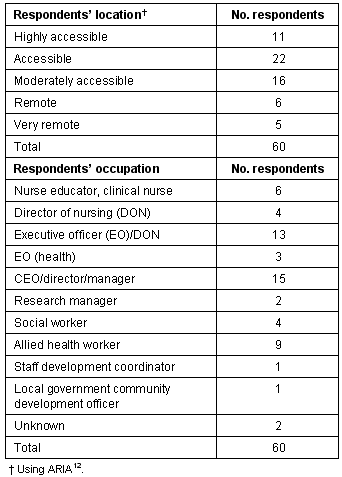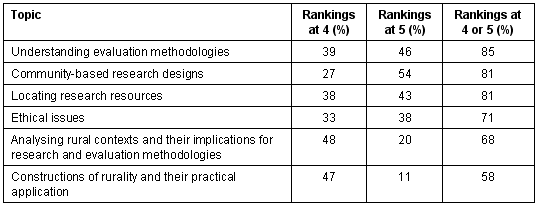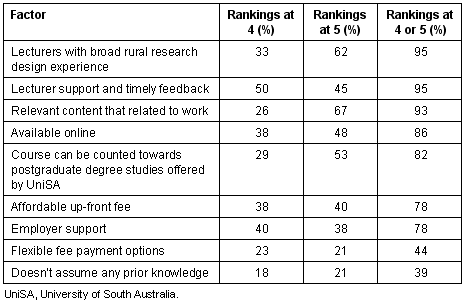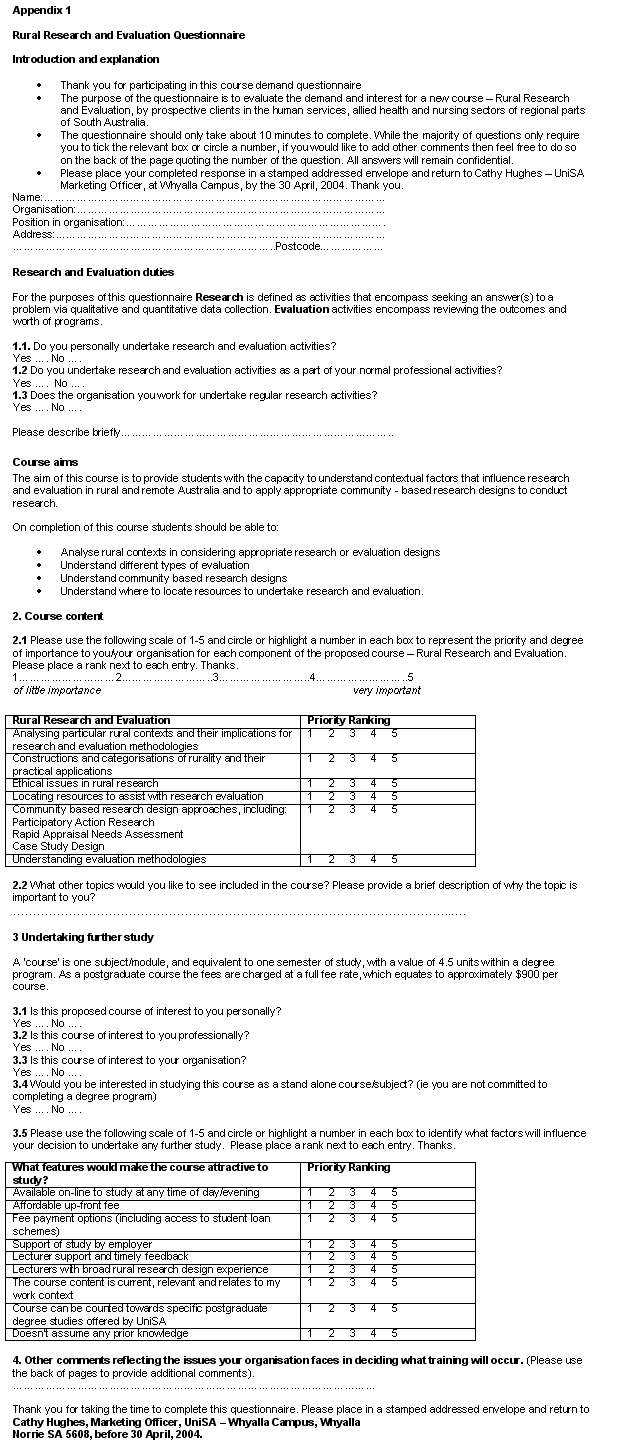Background Do rural and remote health professionals perceive a need for specific context related research training? A cross-sectional survey approach was selected because we wanted to obtain the views of people working in the health, human service, and local government sectors. Three broad areas were canvassed in the survey: (i) current levels of research and evaluation activity; (ii) views about a proposed new course specific to research training in rural and remote locations including proposed main topics; and (iii) features that might make the course attractive to study. The anonymous survey (Appendix 1), with an introductory letter and reply-paid envelope, was forwarded to the CEO (or equivalent) of 141 organisations in rural, remote, and regional locations across South Australia. Organisations included: Most of the survey questions were close ended. A five-point Likert scale was used to rank each proposed course topic and the features that might make the course attractive to study. There was a high level of research and evaluation undertaken by these respondents. Eighty-two per cent undertook research and evaluation personally and 80% undertook these activities as part of their professional roles. However, approximately half (53%) reported that the organisation they worked for regularly undertook research activities. Respondents' research areas included program evaluation, needs assessments, secondary analysis of data, population health research, research to support tenders, and client satisfaction surveys. ________________
Primary Health Care Research Evaluation and Development
Together with an increasing emphasis on rural health research as a distinct entity there is an awareness of the need to develop relevant research education initiatives to ensure that some of the methodological issues that arise can be overcome1-3. A recent project report identified the limited opportunities for undergraduates to receive specific research education and training about rural health research in Canada4. Additionally, an Australian report considered methodological issues when metropolitan researchers undertake research in rural and remote areas5. It would seem, however, that to date there are few university courses specifically on this topic.
The need for innovative research education strategies has been emphasised by the growing numbers of health practitioners, consumers, and communities who are getting involved in research and evaluation. http://www.health.gov.au/internet/wcms/publishing.nsf/Content/health-pcd-programs-pcprograms-collab.htm. The Australian Primary Health Care Research, Evaluation and Development (PHC RED) has contributed to this. This strategy, designed as a program to support the general practice and primary health care research community, aims to develop and enlarge the spectrum of knowledge that underpins the evidence base for general practice and primary health care health services. There are a range of PHC_RED initiatives designed to increase research capacity including post-graduate research programs, provision of seeding grants and bursaries, research networking, for example SANet
Since 2000, the SGRHS located at Whyalla, at the top of the Spencer Gulf in South Australia, has funded 25 small research or evaluation projects in the region. Health practitioners, consumers, and communities are increasingly questioning clinical practices and the way in which these are delivered as a basis for improving healthcare delivery. Additionally, health service delivery models and systems are being evaluated in order to ensure they remain relevant and accessible. Aboriginal communities and organisations are increasingly using research and evaluation to advocate for improved healthcare7. Some practitioners are using the PHC_RED program to 'seed fund' their research. This is one stimulus promoting increased research and evaluation activity within rural and remote regions in South Australia.
Problems facing researchers in rural and remote locations
Rural, remote and regional communities provide unique research contexts but pose challenges when planning research. Our experience has been that researchers, both academics and practitioners, face specific issues in designing research in rural, regional, and remote locations. For example, in some small locations it may be difficult to access demographic data about the health of the population, and the research may have to be designed with this in mind. Often researchers are researching a community in which they live and this poses particular ethical issues. There is always a need to maintain anonymity of research participants and this may lead to some loss of data when a respondent may be able to be identified in a small data pool. Researching 'taboo' topics in small communities also poses significant challenges8.
To date, in assisting practitioners with their research, we have used a 'one-off' approach to deal with these issues, resolving them in each particular situation. However this approach does not enable collaborative learning or debate more broadly. Following discussion with experts in research and evaluation in rural, regional, and remote locations, a number of issues appeared to be common practical stumbling blocks. These issues do not appear to be included in standard research training programs available within Australia
Additionally, there are research designs, such as participatory action research (PAR), that are particularly useful to rural and remote communities who wish to take action about a particular health issue9. Case study designs are often appropriate when wanting to examine phenomena as they occur in a community context10,11.
Recognition of the unique characteristics and challenges proposed by planning and conducting research within rural and remote localities provided the impetus to propose a new research training course specifically to address these needs. We considered both the issues in undertaking research in rural and remote locations, and the research designs we have found useful, and proposed the following topics to be included in a course on rural research and evaluation:
Prior to further developing and offering this course we were interested in obtaining practitioners' views on whether or not a new research and evaluation course would be of value. A university course (subject) within the University of South Australia is a component of study taken as part of an academic program (degree). A number of assumptions were made concerning the development of this new research training course. These included:
Methods
The survey was conducted in early 2004. No reminder notices were issued. Data were collated in Statistica vers. 6 (Statsoft.Inc; Tulsa, OK, USA) and analysed descriptively for each question.
Limitations
It is possible that there was a responder bias within this sample, given that people more active and experienced with research processes and practice may have been more likely to return the survey. Additionally, because it was an anonymous survey and respondents were not asked to identify their organisation, the variety and representativeness of different sectors, for example Divisions of General Practice, could not be determined in the sample.
The use of the five-point Likert scale may have resulted in neutral responses being represented by the score of 3. Therefore, responses of 4 and 5 have been accepted as indicating a positive response while responses of 1 and 2 reflect a negative response.
Results
The survey was returned by 60 people representing a 42.5% response rate. Table 1 presents respondents' occupation and location (using Accessibility/Remoteness Index of Australia12 category) at the time of the survey. The ARIA classification measures remoteness through access by road between populated localities and relevant service centres.
Table 1: Respondents' location and occupation (n = 60)

Results of the survey are presented in four areas:
Current level of participation in research and evaluation activities
Views about proposed course topics
There was consistency in respondents' views that the proposed course topics were appropriate. Respondents rated topics on a five-point scale from 'of little importance' (1) to 'very important' (5). The results are presented (Table 2). The topics 'understanding evaluation methodologies' and 'community-based research design' received the greatest number of 5 (very important) rankings. The topic 'constructions of rurality and their practical application' received the fewest.
Table 2: Respondents' ratings of the importance of the proposed course topics (n = 60)

Features that would make the course attractive to study
Overall 53% of respondents said that they would be interested in studying this course and 79% thought it was of interest professionally. Eighty per cent thought that the course would be of interest to their organisation.
Respondents identified the factors that were considered to be important in making the course attractive. The factors which received most ratings at 5 were 'relevant content that relates to my work' and 'lecturers with broad rural research background'. Respondents' ratings are presented (Table 3). The factors that received fewest rankings at 5 (most important) were 'flexible fee paying options' and 'doesn't assume any prior knowledge'. Almost half (48%) of the respondents ranked online delivery at 5, very important, in making the course attractive to study.
Table 3: Respondents' views on factors that would make the course attractive to study (n = 60)

Other comments
Finally, respondents were asked for comments on issues that might impact on uptake of the proposed course. In all, 15% (18/60) of respondents provided additional comments and the majority of these of these were about the broad ranging budget and time constraints that faced their organisation in planning for professional development of staff. Of those who made comments about barriers to uptake (18/60), 70% mentioned organisational constraints such as the availability of financial resources and other resources to support employees undertaking further training. Additionally, a small number of comments were made about the lack of value placed on research in the respondent's organisation and a lack of overall strategic research direction.
Discussion
The information from this small survey must be used carefully in answering questions about the demand for a course focused on research in rural or remote locations. First, there was a low response rate (42.5%), and it is possible that those people interested in research and evaluation were more likely to return the survey. Respondent bias then may account for the reported high rate of participation in research and evaluation activities. Second, although respondents represented a range of occupations, it is not known if similar levels of need and interest exists across the health and human services and local government sectors. Third, even where respondents reported that such a course was of interest, whether personal interest would translate into course enrolments remains to be seen. While half (53%) of the respondents indicated their interest in studying the course, agreed that proposed course topics were important, and identified features which would make it attractive to study, a number of comments suggested that less than half of the respondents would actually enroll.
However, there are some findings that may assist in developing appropriate research training initiatives for rural and remote practitioners. There was consensus that the proposed course topics were important, that online delivery was appropriate, and among these respondents at least, there was an interest in research and evaluation from people in different types of occupations.
Consensus about proposed course topics
The issues identified as being most commonly problematic or unique in research within small and remote communities were suggested as the framework for the proposed new course. There was a high level of agreement from the respondents that these proposed topics were important and relevant. This may be an indication of the issues overlooked in standard research training programs which require attention for those working within rural and remote locales.
In Australia currently, the majority of programs funded to community-based health and human service organisation require an evaluation be costed into the program. This emphasis on evaluation may have led to this being the most highly ranked topic. The other topic that received a ranking of 5 by over half (54%) of the respondents was 'community-based research design'. This may reflect interest in designs such as participatory action research (PAR), community-based case studies, and designs for community needs appraisal. The PAR cycle of information gathering, planning, action, and refection as a way to inform and modify health programs is gaining recognition in Australia.
Online delivery
Online delivery has been used in Australia to enable students to access courses from their home. Because almost half (47%) of the respondents lived in locations that were, using the ARIA12, classified as moderately accessible, remote, or very remote, it is not surprising that online or modes of delivery that were not dependent on travel or relocation were promoted. Eighty-six per cent of respondents ranked online delivery at 4 or 5 on a 5-point scale as a feature that might influence their decision to undertake such a course. The assumption, made in proposing the course, that online delivery would be highly regarded was supported by the respondents.
Interest in research
The respondents to this survey were from a range of positions in their organisations. Greater than 50% (36/60) of the respondents were from non-clinical or management positions in the organization, and a high percentage (80%) indicated that research was part of their professional role. However, in many rural and remote locations in Australia, management and clinical roles may co-exist, and it is unclear from these results whether or not there is a greater interest in research amongst managers, rather than clinicians.
Conclusions
Implementing the PHC_RED program in our region has meant that some methodological and design issues in researching in rural and remote locations have been identified. We have proposed that these issues are dealt with in a formal research training course made available to personnel in the health and human service sectors and local government. There is consensus among those who responded to our survey that these are important issues and should be included in a research training course.
However, further debate and discussion needs to occur nationally and internationally to advance knowledge about research design in these locations. Mounting a specific course may assist this process. Education about these unique issues may result in increased and more rigorous research and evaluation and, in the longer term, this research may contribute to increasing the evidence-base about rural health.
Acknowledgement
The Australian Government Department of Health and Ageing funds the Primary Health Care Research Evaluation and Development Program.
References
1. Patterson C. The emergence of rural health research in Australia. Australian Journal of Rural Health 2000; 8: 280-285
2. Pong RW. Rural health research in Canada: At the crossroads. Australian Journal of Rural Health 2000; 8: 261-265.
3. Humphries JS. Rural and remote health research in Australia: Past, present and future directions and methodological issues. In: IA Bain, P Buckley, K Harvey (Eds). Proceedings, First National Rural Health Workshop. 1995. Whyalla SA: Australian Institute of Rural Health Research, 1995; 21-35.
4. Kulig JC, Minore B, Stewart NJ. Capacity building in rural health research: a Canadian perspective. Rural and Remote Health 4: 274. (Online) 2004. Available: http://rrh.org.au (Accessed 19 May 2005).
5. Wilkes L. Metropolitan researchers undertaking rural research: Benefits and pitfalls. Australian Journal of Rural Health 1999; 7: 181-185.
6. Taylor J, Fuller J. Rural practitioners as researchers, the Spencer Gulf experience of research development in primary health care. Australian Journal of Primary Health 2004; 10: 104-109.
7. Gentle I, Taylor J. Promoting research in Indigenous communities: Reflections from the Spencer Gulf. Proceedings, First South Australian Collaboration PHC_RED Conference. J Fuller (Ed.) 15-16 October 2003, Adelaide, South Australia. (Online) Available: http://www.phcred-sa.org.au/REDSnapshots2.htm (Accessed 27 May 2005).
8. Edwards J. Invisibility, safety and psycho-social distress among same-sex attracted women in rural South Australia. Rural and Remote Health 5: 343. (Online) 2005. Available: http://rrh.org.au (Accessed 19 May 2005).
9. Groft JN, Hagen B, Miller NK, Cooper N, Brown S. Adolescent health: a rural community's approach. Rural and Remote Health 5: 366. (Online) 2005. Available: http://rrh.org.au (Accessed 19 May 2005).
10. Humphreys JS, Weinand HC. Health status and health care in rural Australia: a case study. Community Health Studies 1989: X111: 258-273.
11. Yin RK. The abridged version of case study research. In: Bickman L, Rog DJ (Eds). Handbook of applied social research methods. Thousand Oaks, CA: Sage, 1998; 229-259.
12. Department of Health and Aged Care and Adelaide University. Accessibility/Remoteness Index of Australia (ARIA). Occasional papers series no. 6. Canberra, ACT: Department of Health and Aged Care, 1999.

Abstract
Background: There is increased interest in building research capacity in rural health research in Australia and internationally. In Australia, the Primary Health Care Research Evaluation and Development program funded by the Australian Government has supported this move. Overall this program aims to build the quantum of primary healthcare research to underpin clinical practice, health systems improvement, and policy. In order to achieve this objective, one strand of the program aims to build research capacity among practitioners. In implementing this program in rural and remote areas of the west of South Australia, the Spencer Gulf Rural Health School has identified methodological and research design issues faced by practitioners who are researching in their communities. These issues include problems encountered in living and researching in the same location and accessing small-scale statistical information. We were interested to know whether there was interest in a formal course (Rural Research and Evaluation) that would address these issues and provide information about community-based research designs.
Methods: A cross-sectional anonymous survey was designed and sent to 141 organisations in the health, human service, and local government sectors in regional South Australia. Respondents were asked to evaluate the demand and interest for a new course - Rural Research and Evaluation. The term 'rural' was used to refer to both rural and remote locations. Information was sought on the respondent's role in the organisation, current level of research participation, views about the proposed course content, and factors that the respondent thought would facilitate or inhibit their participation. The majority of questions were close-ended.
Results: Sixty surveys were returned giving a 42.5% response rate. Data were analysed using descriptive statistics. A high level of research and evaluation activity was reported with 80% of respondents undertaking research or evaluation as part of their professional role. There was also agreement that all the proposed topics were important to be included in a course. Each of the topics was ranked at four or five on a five-point scale by at least 58% of respondents. The topic 'understanding evaluation methodologies' was ranked at four or five by 85% of respondents, making it the most highly ranked topic. There was also consensus about the features respondents thought would make the course attractive for them to study. Over half (62%) of the respondents ranked having lecturers with a broad rural research background at five, very important, on a five-point scale. Almost half (48%) of the respondents ranked online delivery at five, a very important factor in making the course attractive to study.
Conclusions: Those interested in research and evaluation may have been more likely to return the survey and there may have been respondent bias in this regard. Therefore the results must be interpreted with caution. However, the level of agreement with the proposed course topics may suggest that these reflect important issues in undertaking research and evaluation in rural and remote locations. If this is the case there is value in discussion about how these issues are dealt with in different contexts in order to overcome some of the barriers to effective research.
Key words: research capacity building, research education.
You might also be interested in:
2012 - Obesity, dyslipidemia and cholesterol gallstone disease during one year of Antarctic residence


